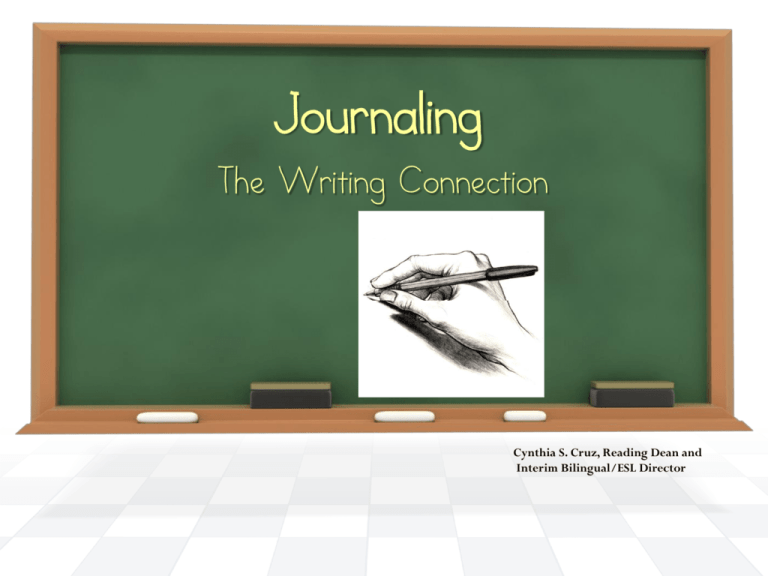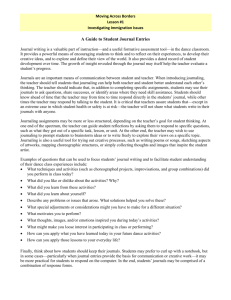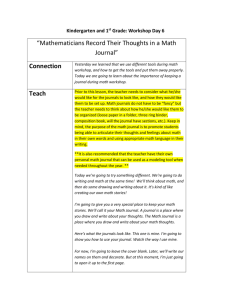Journaling for Leadership PPT
advertisement

Journaling The Writing Connection Cynthia S. Cruz, Reading Dean and Interim Bilingual/ESL Director Best Practices for Teaching Writing 1. 2. 3. 4. 5. Writing IS thinking. We learn to write by writing. We not only learn to write, but write to learn. We use formal writing for: Learning to Write We use informal writing for: Writing to Learn **Journaling, note-taking and learning logs are forms of informal writing. What is journaling? Journaling is a strategy integrating structured writing activities that are used to monitor learner understanding of reading selections/specific content/specific skills. Why is journaling important? COMMUNICATION In order to communicate their thinking to others, students naturally reflect on their learning and organize and consolidate their thinking about the specific content Writing creates a record of our thinking that we can analyze and reflect upon A student often knows more than he or she can explain verbally, writing helps the student to uncover more of what is known and to express it How will journaling increase understanding? Journaling increases learner understanding by assisting in the: learning of new content interpretation of new content use of schemata to construct new knowledge refinement of prior knowledge Journaling can be used to facilitate learning in all content areas when students: have a clearly defined purpose to write construct meaning with new information-transform printed text into their “own language” use writing as a means for building knowledge and a way to self-evaluate their learning/observations think critically: draw conclusions, predict, question, justify, summarize make personal connections use academic vocabulary to explain their learning How do we set up journals and use them? When setting up journals some suggest— composition books loose leaf notebooks file folders different forms of paper to turn in ALL SAY WRITE IN THE JOURNAL EVERYDAY AND DEVELOP A SYSTEM FOR DISTRIBUTION AND COLLECTION What framework can be used when implementing journaling? Journaling at the beginning of every class Journaling before, during, or after reading Journaling before, during, or after teaching a concept/skill Journaling at the end of every class *A teacher should always model the process of journaling first. Practice composing several journal entries together and then have students work on their own. Use a timer to help keep students writing/focused. What are some methods to record information? Prediction journals Response journals Dialogue journals Double-entry journals Cornell notes Learning logs Reflective journals Before Reading/Teaching Concept Prediction Journals stress… establishing and clarifying a purpose for reading activating prior knowledge and making connections previewing the text structure and new vocabulary generating a key question – developing a plan for reading making predictions about what will be learned examining major concepts to be learned, identifying reading strategies used during the reading assignment Sample Prediction Journal The prediction journal is designed to ask five key questions - Prediction Journal 1. What are some things you already know about the passage/concept? 2. What are some predictions about the passage/concept? 3. What are some concepts you are trying to understand? During Reading/Teaching Concept Response Journals Dialogue Journals Double-entry Journals Cornell Notes designed to foster: interaction with the text/concept re-reading of difficult text – review of the concept summarizing reflecting on information that was recently read or introduced Response Journals Encourage students to: think elaborate their thoughts make connections (text to text/text to self/ text to world) synthesize their ideas and understandings at a critical juncture in the reading process/lesson develop questions for clarification to ask of themselves, the text, classmates, or teacher explain what they have learned Response journals may include: notes new ideas sketches and drawings concepts, views, and opinions words – new/unknown reflections about the lesson – strategies I used questions/answers stories, poems, lists, and any other writings quotes, sayings, and expressions Sample Response Journal Dear Mrs. D., I am writing to you about a true story, called Paddle to the Amazon by Don Starkell and Charles Wilkins. It is about a man and his two sons paddling all the way to the Amazon in only a canoe. Because they wrote the book they obviously survived the journey. Right now, in the book, they are just approaching the Gulf of Mexico. They were from Winnipeg and started in Winnipeg. While they were traveling across the USA they encountered many generous people who shared all that they had with them. But they ran into some not too nice people who mugged them and stole their supplies. They have taken the Red River to the Mississippi and are entering the high seas of the Gulf of Mexico. I predict that they will encounter even more tough times on their journey when they entered big water, the ocean, which at times can be unpredictable and dangerous. I also think that their boat will not hold up and they will have to go through the trouble of getting a new one. The only way that I can connect with this story is that my dad an I sometimes go on long hikes, canoe trips things like that. I sometimes do not enjoy them but I know that it can be really rewarding in the end if you conquer something that you did not think you could. You can achieve victory if you set your mind to it and if you work hard. When I compare the characters to classmates I would compare the father Don to Jayne because they are both born leaders. I would compare Dana (one of the sons) to Matt M. Because they both share a love for music and have a lot to offer. As for Jeff, I would compare him to Liam because they are both shy but once you get to know them they become very interesting. This story was written in first person and it was suitable because it was easier to follow the events and it made good sense because Don's journal was written in first person as if he were telling the story. This book has been really long and if the author took out a bit here and there it would keep the reader's attention and they would want to keep reading it and not stop. Compared to deathwatch this book was slower in starting off because all they said was that they were getting anxious and worried. Dialogue Journals (Buddy Journals) The student writes an entry on a topic. The teacher comments on the student’s entry, expands the topic and/or asks questions. The purpose is not to correct what the student wrote but to expand on it and model attributes of writing such as letter formation and conventional spelling. The student then answers the questions and offers additional comments before adding new thoughts. The entries may be one or two sentences long or longer, depending on the level of the student. The student is encouraged to use invented spelling as needed. Sample Dialogue Journal 1st grade student after reading “Clifford the Big Red Dog” Student’s writing: I hve a dog. Hz nam is Skardy Hair. He ets meet. Teacher’s response: I like the name Scaredy Hair. How did you pick his name? I have a dog too. Her name is Pixie. Pixie likes meat too. What do you like to do with Scaredy Hair? I like to go for walks with Pixie. Double-entry Journals Using a Two Column/T-note format, the double-entry journal allows students to record dual entries that are conceptually related The Double-entry Journal: A Myriad of Options On the left: The Source On the Right: The Response Notes from the text Summaries/Comments/Images Observations Interpretations Facts Questions, Quick Reponses Key Words or Phrases Observations/Questions/Definitions Concepts & Ideas Explanations/Questions Author’s Predictions (based upon a text portion, excerpt) Reflections Facts, details, statements My Predictions/Questions Double-entry journals have a heading on each of the columns to reflect their purpose. Possible headings might be: What is it?/What does it mean? What I learned from the demonstration./How the demonstration helped my understanding. Words I need to know./Definitions of words I need to know. Ding: I get it!/Dong: I don’t get it! What I thought before reading./What I think after reading. Ways to solve the problem./How the problem is solved. Problem(s) I encountered./How I solved the problem(s). Sample Double – entry Journals Cornell Notes A two column note-taking system Record – during the lesson, use the note-taking column to record information using short sentences Questions – formulate questions in the cue column (questions help clarify meaning, reveal relationships, establish continuity and strengthen memory) Recite – cover the note-taking column and try to answer the questions – say the answers aloud in your own words Reflect – reflect on the material by asking yourself other critical questions Summarize – write a brief summary Review – spend at least a few minutes every week reviewing all your previous notes After Reading/Teaching Concept Learning Log Reflection Journals designed to: help identify and analyze strategies used to make meaning of the text/concept make connections between and with the text/concept paraphrase ideas and understandings Learning Logs One of the most effective methods of writing to learn is for students to keep a learning log. Learning Logs: 1. provide ongoing records of what students have learned 2. allow reflection and reactions to class activities (problems, questions, concerns, etc…) 3. focus on content **Writing in learning logs takes 3 to 5 minutes “think time” and 5 minutes writing time (allow time to discuss the learning log at a later date and reflect on the ideas) This strategy is simple to implement but must be used on a regular basis to be effective. Sample Learning Logs Reflection Journals After the reading passage/lesson is completed the teacher may choose to use a reflection journal. The reflection journal tends to be simple in format – basically it is the writer’s reflection of the passage/topic/concept. This type of writing can help you gain a deeper understanding of the content. What happened? How do I feel about it? What did I learn? Sample Reflective Journal What are some other methods to record information? Observation journals – students conduct an investigation on a particular topic and collect and record their findings/explain their mathematical reasoning, etc… – drawings/charts should be included Process journals –students explain new information or processes in their own words Metacognitive journals – students write what I learned, and how I learned it Synthesis journals – students write what I did, what I learned and how I can use it Point of View journals – students write from an assigned point of view (Science - a student might assume the role of the scientist who discovered a vaccine, a person infected with the disease, etc…) Personal journals – the best thing about this is that there aren’t any rules you don’t have to be concerned about spelling, format or content – You can let your thoughts run wild! No matter what method of informal writing you choose it should take place in ALL content areas DAILY!!! Things to remember: Always model the writing first. Be specific about the writing requirements (what you expect). Journal entries differ from essays and reports. Journal entries can be short and explanatory. The main purpose is to reflect on the content one has learned. Provide periodic feedback (try not to grade every journal entry – if any). Periodically allow students to share their writing with each other or with the entire class (let them know before hand). Periodically share your own writing. Keep the writing routine and structure consistent. Periodically allow students choice in the writing. “I hear and I forget; I see and I remember; I write and I understand.” --Chinese Proverb Have a GREAT School Year!! and Have FUN doing your job!!





